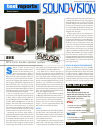
GRAYSCALE
Before Calibration
SVS MTS speaker system
test repor ts
SVSOUND.COM :: 877-626-5623
scale and virtually without character in
the ever-sensitive vocal regions. (Lack of
character is a good thing for a speaker; not
so much for a speaker reviewer.)
When combined with the MTS-01’s
superb bass, which sounded pretty much
unfettered to nearly 30 Hz, this made for
an outstanding listening experience. Great
recordings, such as guitarist Ralph Town-
er’s classic Solstice, were reproduced with
an evenness of timbre and an image depth
rarely found in so affordable a speaker.
SVS’s spiffy tweeter really did shine on
the 12-string-guitar-and-drums duet “Pis-
cean Dance,” where drummer Jon Chris-
tensen’s stuttering snare and hi-hat and
floating ride cymbals shone with a nota-
bly unstressed, no-limit airiness.
While SVS had suggested that I cross
the towers over at 80 Hz to let the mas-
sive subwoofer do its thing, I found that
running them full-range and crossing
over the system’s center and surrounds
at 60 Hz delivered the best, most cohe-
sive sound, particularly on multichannel
music. And pretty glorious sound it was,
too, on a Telarc SACD of the Cincinnati
Symphony Orchestra playing Stravinsky’s
Firebird Suite. The system’s presentation
of massed strings and hall sound was
simply first-rate, while brass attacks and
inner details like sidewall echoes from
the glockenspiel sounded consistently
clear and lifelike. Under it all, the PB13-
Ultra sub contributed seemingly limitless,
but controlled and unexaggerated, bottom
end. I’ve never heard the Cincinnati’s big
bass drum sound bigger, nor have I heard
its climaxes in unison with the tympani
during the “Infernal Dance” scene deliv-
ered with deeper impact.
Hidalgo isn’t a very good movie, but
it does offer well-photographed vistas
on Blu-ray Disc, a sweeping James New-
ton Howard musical score, and plenty
of action — once you get past the notion
of Aragorn as a cowboy. The SVS system
delivered wholly cinematic soundscapes,
with solid spatiality and effortless dynam-
ics; indeed, this system sounds better the
louder it plays. Dialogue was uniformly
clear and stable (though maybe not as
tightly locked to the screen as it would
be with the very best speaker systems),
while the L/C/R trio maintained a solid
front during the film’s countless pans of
galloping hooves.
The MBS-01s — located in my usual
surround speaker position on high shelves
flanking my listening position and angled
in somewhat toward the rear wall — per-
formed surprisingly well. I never once felt
my attention pulled away from the screen,
though my everyday dipoles clearly
sounded bigger and more amorphous,
which I feel is a virtue with most movie
soundtracks.
The PB13-Ultra was quite possibly the
best subwoofer I’ve ever had in my sys-
tem. It went lower and louder than any
single-piece sub I’ve tried here, and it did
so without producing a hint of excessive
sound on the middle-bass octaves from
60 Hz on up. Even without exploiting any
of its EQ features, the PB13-Ultra easily
awoke rattles in my room that only one
other sub (the JL Audio f112) has found.
And scenes such as the sliding tomb door
in the opening moments of the Stargate
DVD caused it to deliver truly structural
rumbles at cinematic levels.
As with the MTS speakers, the PB13-
Ultra has foam bungs for its three cabinet
ports. And it produces enough bass that I
found employing all three bungs to be an
ideal option in my room. Doing so barely
tightened the already well-controlled
sound, and even with its peak 3-Hz level
thus curtailed (a sealed enclosure returns
deeper extension but slightly less peak
loudness higher up the frequency range),
the SVS sub still could play substantially
louder than I could ever demand.
BOTTOM LINE
SVS’s MTS system, complemented by the
PB13-Ultra sub, is as impressive a music
system as it is a home theater one. Any
value-conscious audio seekers who care
more for performance than pedigree, and
for great sound more than mere style,
should look and listen no further.
S&V
Key Features
Test Bench
All measurements were taken with the tweeter-level
switch in the 0-dB position. The MTS-01 has a 5-dB
floor-bounce swallow centered at 244 Hz with fairly
significant roughness above that point and a 3- to 5-
Surround ■■ 129 Hz to 16.7 kHz ±2.4 dB
Subwoofer ■■21 Hz to 59 Hz ±1.8 dB
L/R ■■34 Hz to 17.1 kHz ±5.1 dB
Center ■■33 Hz to 18.2 kHz ±6.1 dB
MTS-01 ($1,499 a pair)
:: 1-in soft-dome tweeter, two 6
1
⁄
2
-in cone
woofers; 41 x 13 x 10
in; 60 lb
MCS-01 ($599)
:: 1-in soft-dome tweeter, two 6
1
⁄
2
-in cone
woofers; 10 x 24 x 13
in; 39 lb
MBS-01 ($999 a pair)
:: 1-inch soft-dome tweeter, 6
1
⁄
2
-in cone
woofer; 16 x 13 x 10
in; 27 lb
PB13-Ultra ($1,599)
:: 13-in proprietary cone woofer; 750-watt
amplifier; 22 x 20
1
⁄
2
x 28 in; 155 lb
Full lab results at soundandvisionmag.com/SVSMTS
dB elevation between 5 and 9
kHz. The MCS-01 displayed a
deep, narrow notch just above 3
kHz at every listening angle. But
this notch doesn’t become
severe until ±45º off-axis —
beyond the range of a typical
seating position for viewing mov-
ies. The MSB-01 surround chan-
nel has a wide radiation pattern
and the smoothest response of
this set. Each speaker’s treble-
control switch reduced high fre-
quencies above around 3 kHz by
approximately 2 dB. The PB13-
Ultra is a true subwoofer in that
it will produce significant sound
pressure below 25 Hz. It also
has fantastic bandwidth unifor-
mity, producing a 103-dB aver-
age SPL over 10 to 62 Hz.
— Tom Nousaine
Copyright © 2008 Hachette Filipacchi Media U.S., Inc. All Rights Reserved.
For more information about reprints from Sound & Vision, contact Wright’s Reprints at 877-652-5295.
50835
20 100 1k 10k 20k
hertz (Hz)
15
10
5
0
–5
–10
–15
decibels (dB)




